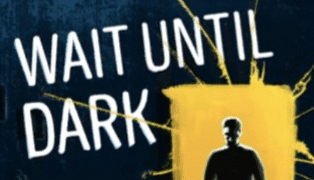LOGAN — Last summer, in my review of Utah Festival Opera & Musical Theatre’s Show Boat, I wrote of the disillusionment of returning to a beloved venue from one’s childhood only to face a reality that doesn’t live up to the memories. So I admit I felt some trepidation this year about revisiting another Logan institution: UFOMT’s older and smaller-scale neighbor from around the corner, the Lyric Repertory Company. I was a frequent patron of the Lyric in the ’80s and ’90s, but have not been back in twenty years. However, I am very relieved to report that this year’s production of Wait Until Dark, directed by Lyric Rep’s artistic producer, Adrianne Moore, has shown my misgivings to be baseless. Rest assured that the Lyric’s legacy is safe and my nostalgia for it unabated.

Show closes August 5, 2017.
Since this is UTBA’s first year fully covering the Lyric, it’s worth mentioning that, for those who live too far south of Logan to know what you’re missing, the Caine Lyric Theatre (the “Caine” was added after a 2001 restoration) may be my favorite venue in the state. Built in 1913, it has housed Lyric Rep since the 1960’s. Not to be confused with the also recently refurbished Utah Theatre, the art deco movie house-turned-live performance space next door, the 374-seat Caine Lyric is an intimate, historic “jewel box” reminiscent of a London music hall from a century ago. It’s particularly well suited to a thriller like Wait Until Dark, where the building is small enough and old enough for audience members to expect a grim shadow or two, and where greater proximity to the actors makes patrons feel closer to the danger.
Wait Until Dark takes place in the New York basement apartment of Susan and Sam Hendrix (played by Lacy J. Dunn and Mitch Shira, respectively). Sam has recently returned home only to open his valise and find a mysterious doll, which subsequently disappears. When the con men who are after the doll and what it conceals—Harry Roat (played by Lance Rasmussen) and Sergeant Carlino (played by Wyn Moreno)—are unable to recover it by appealing directly to Sam or searching the apartment, they contrive a way to get him out of the house for a day in order to intimidate Susan into revealing the doll’s whereabouts. Susan has some assistance from a neighbor girl, Gloria (played by Dani Rae Nielsen), and Mike Talman (played by Chris Klinger), who claims to be a friend of Sam’s from the war. But ultimately Susan must take on the criminals alone. Roat assumes Susan will be an easy target because she is blind, but she outsmarts him, turning what he perceives as a weakness to her advantage in the final scene foreshadowed by the play’s title.
Those familiar with Frederick Knott’s 1966 script or the 1967 film with Audrey Hepburn will be surprised at the differences in the Lyric Rep’s production, most prominently the fact that it is set in 1944 instead of the 1960’s. Moore has chosen to use a version of the play adapted by Jeffrey Hatcher for a Los Angeles production in 2013, which employs the change in period as a vehicle for massaging some of the more far-fetched aspects of the original. It’s a net positive, though I wondered if it also didn’t warrant a more noir approach to the lighting.
Speaking of the period, I admired much about Spencer Potter’s set, such as the bricked-over archways in Susan’s Greenwich Village basement apartment, the exposed electrical tubing coming down from the ceiling into the fuse box, and particularly the distressing of the walls, molding, and doors, which was beautifully done. In fact, it was so well done that it made the exposed brick look a little too crisp and clean by comparison, and the frameless Home Depot stock cabinets couldn’t quite blend in (especially when they were opened). Moreover, the heavy safe, which Susan claims they “can’t even pick up,” needs to stop rattling everything on top of it every time it is touched, and I wish the floor of the raised kitchen area didn’t creak. It makes it hard to accept that people are hiding right in front of Susan when we’re also supposed to believe that she can tell a person’s identity by the sound of their shoes.
Likewise, a major reveal in the first scene (which I don’t want to give away), while a great visual, could never evade Susan’s talents of detection. Even assuming she doesn’t accidentally touch it, she would notice by scent, by weight . . . by something. It makes the suspension of disbelief creak like the kitchen floor. This matters because Wait Until Dark is very vulnerable to, “But wait, why doesn’t she just . . .” kinds of objections if the audience is given too much time to think.
Fortunately, Dunn’s compelling central performance keeps the focus on her character and how she perceives her surroundings through the physicality of her blindness. At once vulnerable and formidable, her serenely intense presence commands enough attention to deprive most concerns about plausibility of their oxygen until after the final curtain. The rest of the cast’s acting is also strong, featuring consistent and non-distracting accents. Klinger’s Talman deftly navigates shades of conflicting emotions and motivations, and I was delighted that Rasmussen imbued even Roat’s most mundane actions with touches of the sinister. After all, it is only a very dangerous man who, when offered aspirin, would drink his water before swallowing the pills.
Given how well Moore and the cast managed the tension throughout the play, the climax didn’t pay off as well as I expected. Perhaps this is partly due to the fact that I already knew what would happen, but a well-staged thriller shouldn’t need to depend on first-timers. My best guess is that it is because part of the action occurs offstage, weakening its impact with the increased distance and muddying the sequence of events just a hair. I can see why Moore made that choice in terms of setting up the most memorable moment of the scene, but I think there are other solutions that could have kept the conflict more at the forefront.
But don’t be dissuaded by my quibbles. The quality on display makes it clear how the Old Lyric Repertory Company has lived to see its fiftieth anniversary season. I confess I was sorry not to see Lego Louis or W. Lee Daily among this year’s company (though apparently Daily will make an appearance at the anniversary celebration), but founder W. Vosco Call is still treading the boards. Moreover, my experience at Wait Until Dark — alongside my colleagues’ reviews of The Complete Works of William Shakespeare (Abridged) and Big River — tells me that Lyric Rep is in as fine a form as ever.





